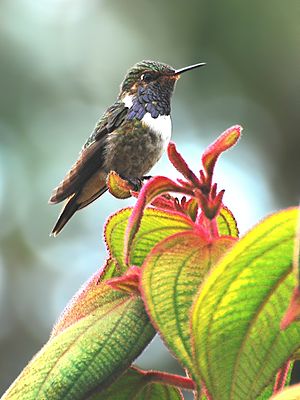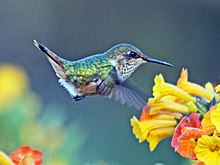Volcanic elf
| Volcanic elf | ||||||||||
|---|---|---|---|---|---|---|---|---|---|---|

Volcanic elf, male |
||||||||||
| Systematics | ||||||||||
|
||||||||||
| Scientific name | ||||||||||
| Selasphorus flammula | ||||||||||
| Salvin , 1865 |
The volcanic elf ( Selasphorus flammula ), sometimes also called wine-throated hummingbird or cherry-throated hummingbird , is a species of bird in the hummingbird family (Trochilidae).
distribution
The species lives in the mountains of Costa Rica and in the province of Chiriquí in western Panama at an altitude of 900 to 2500 meters.
Appearance
The hummingbird reaches a body length between 7.5 and 8.0 centimeters and weighs 2.5 to 2.8 grams. It has a black straight beak and black feet. The males are slightly smaller and lighter than the females. Mainly the three subspecies differ in the color of the throat. The plumage of the males is in the area of the throat in the area of the volcanoes Barva and Poás (subspecies S. f. Simoni ) shimmering pink and in the area of the Cordillera de Talamanca (subspecies S. f. Torridus ) violet-gray or violet-green as well in the Irazú-Turrialba area (subspecies S. f. flammula ) dull purple. The front chest is white-gray in color. The back is greenish and the top of the tail is greenish, brown and orange in color. The females are significantly less colorful. They have a white throat and a white color with black spots on the underside of the head. Young birds resemble the females in terms of plumage. The species can most likely be confused with the orange-throated elf ( Selasphorus scintilla ).
food
The diet of the volcanic elves consists mainly of flower nectar and pollen . The nectar is absorbed from the flowers while hovering. In addition, the hummingbirds eat insects , which ensures a sufficient supply of protein .
Reproduction
After mating , the females build a nest made of cobwebs , plant wool , lichen or moss . The nest is built hidden in a bush or tree.
Danger
The natural enemies of the hummingbird are snakes , cats and birds of prey . The entire population of this species is currently not considered threatened. In the Red List of the World Conservation of Nature Union , the volcanic elf is therefore listed in the "LC" ( least concern - not endangered) category.
Subspecies
There are three subspecies:
- Selasphorus flammula simoni Carriker 1910 in Costa Rica at the volcano Barva , volcano Poás and in the mountain range Cerros de Escazú
- Selasphorus flammula flammula Salvin 1865 in Costa Rica at the volcano Irazú and volcano Turrialba
- Selasphorus flammula torridus Salvin 1870 in Costa Rica in the Cordillera de Talamanca mountain range and at the Barú volcano (Panama)
Etymology and history of research
Osbert Salvin described the hummingbird under its current name Selasphorus flammula . He named the Volcán de Cartago as the site . Although the issue of the magazine says the year 1864, the article did not appear until 1865. "Selasphorus" comes from the Greek words "selas σέλας " for "shine, light, flame" and "-phoros, pherō πηοροσ " for "bearing." "Carrier". The specific epithet »flammula, flamma« is derived from Latin and means »little flame, flame«. "Torridus" is the Latin word for "burnt, parched, burned". Eugène Simon had pointed out to Melbourne Armstrong Carriker that the subspecies »simoni« was clearly different from the fire-throated elf ( Selasphorus ardens Salvin , 1870) and that the name Selasphorus underwoodii, proposed by Ernst Hartert in 1900, was already according to the International Rules for Zoological Nomenclature was occupied by the green-crowned flag sylph ( Ocreatus underwoodii ( Lesson , 1832)). So he honored Simon for this valuable tip.
literature
- Robert Sterling Ridgely, John A. Gwynne: A Guide to the Birds of Panama. With Costa Rica, Nicaragua, and Honduras . Princeton University Press, Princeton, New Jersey 1989, ISBN 0-691-02512-6 .
- Alexander Frank Skutch: Field Guide to the Wildlife of Costa Rica . University of Texas Press, Austin, Texas 2002, ISBN 0-292-73459-X .
- Carrol LaVerne Henderson: Birds of Costa Rica . University of Texas Press, Austin, Texas 2010, ISBN 978-0-292-71965-1 .
- Christopher J. Clark, Teresa J. Feo, Ignacio Escalante: Courtship Displays and Natural History of Scintillant (Selasphorus scintilla) and Volcano (S. flammula) Hummingbirds . In: The Wilson Journal of Ornithology . tape 123 , no. 2 , 2011, p. 218-228 , doi : 10.1676 / 10-076.1 .
- James A. Jobling: Helm Dictionary of Scientific Bird Names . Christopher Helm, London 2010, ISBN 978-1-4081-2501-4 .
- Osbert Salvin: Descriptions of seventeen new species of birds from Costa Rica . In: Proceedings of the Zoological Society of London for the year 1864 . No. 14 , November 8, 1864, p. 579-586 ( biodiversitylibrary.org [accessed November 2, 2014]).
- Osbert Salvin: On some Collections of Birds from Veragua (Part II) . In: Proceedings of the Zoological Society of London for the year 1870 . No. 6 , 1870, p. 175-219 ( biodiversitylibrary.org [accessed November 14, 2014]).
- Melbourne Armstrong Carriker: An Annotated list of the birds of Costa Rica including Cocos Island . In: Annals of the Carnegie Museum . tape 6 , no. 7 , 1910, pp. 314-915 ( biodiversitylibrary.org [accessed November 2, 2014]).
Web links
- Selasphorus flammula inthe IUCN Red List of Threatened Species 2014.2. Listed by: BirdLife International, 2012. Retrieved November 2, 2014.
- BirdLife International: Species Factsheet - Volcano Hummingbird ( Selasphorus flammula ) . Retrieved November 2, 2014 ..
- Videos, photos and sound recordings for Volcano Hummingbird (Selasphorus flammula) in the Internet Bird Collection
- Volcanic Elves ( Selasphorus flammula ) at Avibase; Retrieved November 2, 2014.
- Selasphorus flammula in the Integrated Taxonomic Information System (ITIS)
- xeno-canto: Sound recordings - Volcano Hummingbird ( Selasphorus flammula )
Individual evidence
- ↑ a b Avibase.bsc-eoc.org: Vulkanelfe accessed on November 1, 2014.
- ↑ Alexander Skutch: Field Guide to the Wildlife of Costa Rica. P. 291.
- ^ Carrol L. Henderson: Birds of Costa Rica. P. 291, Selasphorus flammula .
- ↑ a b Hbw.com: Selasphorus flammula accessed on November 1, 2014
- ^ F. Gary Stiles, Alexander Skutch: Volcano hummingbird (Selasphorus flammula). In: A guide to the birds of Costa Rica. Comstock, 1989, p. 242.
- ↑ Selasphorus flammula in the IUCN Red List of Threatened Species 2014.2. Listed by: BirdLife International, 2012. Retrieved November 2, 2014.
- ↑ Burt L. Monroe, Charles G. Sibley: A World Checklist of Birds. , Yale University Press, 1997, ISBN 0-300-07083-7 , p. 74.
- ↑ a b Melbourne Armstrong Carriker, p. 550.
- ↑ a b Osbert Salvin (1865), p. 586.
- ^ Osbert Salvin (1870), p. 208.
- ↑ James A. Jobling p. 352
- ↑ James A. Jobling p. 160
- ↑ James A. Jobling, p. 388.
- ^ Melbourne Armstrong Carriker, p. 551.

